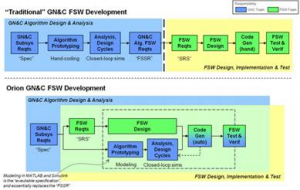Guidance, Navigation and Control System used in Orion’s successful deep space test flight built using Model-Based Design
BENGALURU, India – (26 February 2015) – MathWorks detailed its contribution to the successful completion of NASA’s Orion spacecraft test flight. The flight, completed on December 5th 2014, marked the farthest in space any spacecraft designed for astronauts has been in more than 40 years. Orion’s milestone is considered a significant step in NASA’s work to pioneer deep space flight and reach Mars with a manned spacecraft. The guidance, navigation and control (GN&C) system onboard Orion successfully navigated from launch to landing using GPS and inertial sensors. These GN&C algorithms were developed with auto-generated code from MATLAB and Simulink.
The design and development of the GN&C flight algorithms for Orion was a partnership between NASA, Lockheed Martin, Draper Laboratory, MathWorks and others. Model-Based Design helped the organizations work on both the GN&C algorithm and flight software development concurrently. Simulink models of the spacecraft and controllers served as an executable specification allowing engineers to design, verify and automatically generate flight software from one set of models. As a result, the GN&C analysts worked directly with the executable algorithm models rather than with documents which would have required interpretation by software developers. Merging the design and analysis environment with the flight software development enabled the joint team to identify and resolve problems earlier and reduce overall development time.

“Guiding the Orion craft to a splash-down point within a half mile of its chute deploy target required the strengths of the entire team,” explained Mark Jackson, Draper Laboratory’s GN&C integration lead for the NASA team. “By combining Draper’s entry guidance algorithm with the auto-generated code capability of MATLAB and Simulink, the team met NASA’s objectives for landing guidance, navigation, and control.”
“MathWorks is very excited to play an important role in NASA’s journey to Mars,” said Jon Friedman, aerospace manager at MathWorks. “Being able to create the GN&C algorithms, simulate the closed-loop system using MATLAB, Simulink and Stateflow, and then to automatically generate C++ for deployment on the spacecraft provided significant quality and time-saving benefits for the mission.”
More details about how the GN&C was developed using MATLAB and Simulink can be found in “Accelerating NASA GN&C Flight Software Development.” Also, more details about Orion and its mission can be found on NASA’s Exploration: Beyond Earth site.






